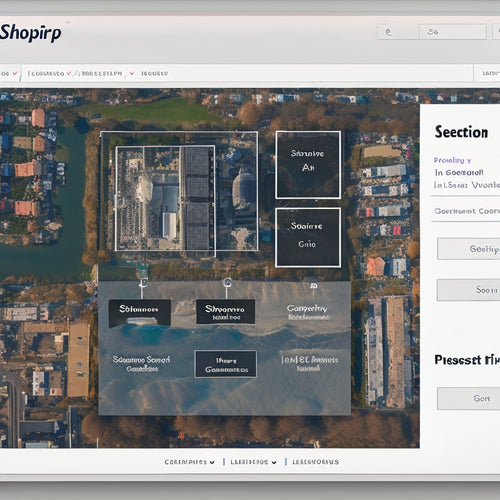
Enhance Product Visibility: Mastering Pattern Attributes
Share
Mastering pattern attributes is essential for enhancing product visibility in Google Shopping. Pattern attributes distinguish products, catering to customer preferences and influencing search result accuracy. Effective pattern selection improves product visibility, showcasing unique designs and variations. In categories like apparel and furniture, pattern attributes are necessary for accurate search results and customer filtering. By providing correct and recognizable pattern values, merchants can guarantee precise product visibility and drive relevant traffic. To access the full potential of pattern attributes and elevate product visibility, understanding the intricacies of pattern attributes and their strategic application is crucial.
Key Takeaways
• Accurate pattern attributes enhance product visibility by highlighting unique designs and catering to customer preferences in Google Shopping.
• Effective pattern selection is crucial in categories like apparel, furniture, and bathroom accessories where pattern variations define distinct variants.
• Providing correct pattern entries, such as recognizable and distinct patterns, improves search result accuracy and product differentiation.
• Utilizing e-commerce platforms and Merchant Center feed rules simplifies the process of optimizing pattern attributes for better product representation.
• Mastering pattern attributes ensures precise product visibility, driving relevant traffic, and enhancing ad performance in Google Shopping.
Understanding Pattern Attributes
The pattern attribute, an essential element in product feeds, serves as a descriptive feature that highlights the unique design or visual pattern on a product, thereby facilitating product differentiation and visibility in Google Shopping.
This attribute is particularly vital in product categories like apparel, furniture, and bathroom accessories, where pattern variations can make or break a sale. Effective pattern selection, driven by customer preferences, can greatly enhance product visibility.
Is the Pattern Attribute Required?
In scenarios where pattern variations have a significant impact on product uniqueness, the pattern attribute becomes an essential element in the product feed.
This is particularly true for products where pattern variations define distinct product variants, such as shirts with stripes, plaid, or paisley patterns.
When customers search using pattern descriptions, including pattern info is vital to guarantee accurate search results.
The pattern attribute is necessary for catering to customer preferences, allowing them to filter search results based on their desired patterns.
Using Patterns in Google Shopping
Pattern data plays a critical role in Google Shopping by facilitating effective filtering of search queries and influencing search result accuracy. By utilizing pattern attributes, merchants can enable customers to filter search results based on their pattern preferences, leading to more precise product visibility.
Effective pattern selection is key to visual differentiation, allowing products to stand out in a crowded marketplace. In Google Shopping, pattern data is used in conjunction with other product attributes to deliver accurate search results. By providing accurate and recognizable pattern values, merchants can improve the quality of their product listings, driving more relevant traffic and ultimately, enhancing ad performance.
Providing Pattern Entries Correctly
To guarantee precise and recognizable pattern values, it is essential to follow specific guidelines when providing entries for the pattern attribute. This guarantees that your product feed accurately reflects the unique patterns of your products, enhancing their visibility in Google Shopping.
| Pattern Attribute Guidelines | Description |
|---|---|
| Accurate Entries | Ensure pattern values are accurate and recognizable |
| Single Entry | Only one pattern entry per product is considered |
| Distinct Patterns | Specify a distinct and recognizable pattern |
| Relevance | Use pattern entries when the variant is defined by the pattern |
| Concise | Pattern values must not exceed 100 Unicode characters |
Adding Patterns to Your Feed
When integrating pattern attributes into your product feed, e-commerce platforms and Merchant Center feed rules provide a convenient way to add and edit pattern data for your products. This simplifies the process of optimizing your pattern attributes, ensuring that your products are accurately represented and easily discoverable by customers.
To effectively add patterns to your feed, follow these best practices:
-
Utilize e-commerce platforms: Leverage platforms like Shopify or Magento to easily add pattern values to your products.
-
Set up Merchant Center feed rules: Define rules to automatically add or edit pattern data for specific product groups.
-
Ensure accurate and recognizable patterns: Provide clear and concise pattern descriptions to enhance search result accuracy and improve customer experience.
Common Pattern Attribute Issues
Incorrectly implemented design attributes can lead to a range of issues in product feeds, compromising the accuracy of search results and ultimately, the shopping experience.
One common mistake is inputting irrelevant product details, such as size or material, under the design attribute. This can lead to feed discrepancies, making it important to double-check design values when troubleshooting design values.
Typographical errors can also occur, further exacerbating the issue. To resolve feed discrepancies, merchants must make sure accurate and recognizable design entries. This involves avoiding irrelevant details and specifying distinct designs.
Importance of Patterns in Visibility
Accurate pattern attributes play a vital role in enhancing product visibility. They enable customers to find specific products that match their desired patterns, increasing the likelihood of conversion. This is particularly important for products with significant pattern variations, such as apparel items or home decor.
By including pattern attributes in the product feed, merchants can:
-
Improve pattern selection: Allow customers to filter search results based on specific patterns, increasing the chances of finding the desired product.
-
Enhance visibility impact: Increase product visibility by providing relevant pattern information, making it more likely to appear in search results.
-
Boost conversions: Showcasing products with accurate pattern attributes can increase the likelihood of customers making a purchase.
Frequently Asked Questions
Can I Use the Pattern Attribute for Products Without Visible Patterns?
Imagine a sleek, solid-colored sofa - no patterns in sight. For non-pattern products, refrain from using the pattern attribute, as it's meant to highlight unique designs. Instead, explore alternative attributes that showcase other distinct features, ensuring accurate and relevant product data.
How Do I Handle Pattern Variations for Products With Multiple Colors?
For products with multiple colors, handle pattern variations by creating separate product feeds with distinct pattern attributes, ensuring accurate visual merchandising and categorization, and consider color-coded product display to enhance customer experience.
Are There Any Language-Specific Guidelines for Pattern Attribute Entries?
As the linguistic tapestry of the world unwinds, language-specific guidelines for pattern attribute entries emerge. Guarantee consistency by following guidelines for language restrictions, handling variations for non-visible patterns, and avoiding cultural missteps, weaving a seamless shopping experience for global customers.
Can I Use the Pattern Attribute to Highlight Product Features Like Fabric Type?
No, the pattern attribute is intended to describe visual patterns, not fabric type or material composition. Instead, focus on highlighting design elements, such as stripes or polka dots, that impact visual appeal and fabric texture.
Are There Any Google Shopping Policies Specific to Pattern Attribute Usage?
Google Shopping carefully examines pattern attribute usage, imposing restrictions on character limits, accuracy, and relevance to prevent misinformation. Adherence to these guidelines guarantees compliance and best product visibility, while mitigating the risk of feed disapprovals and penalties.
Related Posts
-

Scale Your Online Store With Digital Solutions
You can scale your online store exponentially by integrating digital solutions that overcome common e-commerce hurdle...
-
Shopify Sitemap: Find & Submit Your XML Sitemap to Google
This article aims to provide information on Shopify sitemap optimization, specifically focusing on finding and submi...
-

Adding Sitemap to Your Shopify Store: A Complete Guide
This article aims to provide a comprehensive guide on the process of adding a sitemap to a Shopify store. A sitemap ...

